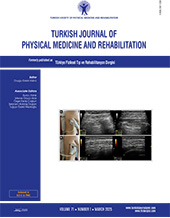Evaluation of response to treatment in breast cancer-related lymphedema
2 Department of Physical Medicine and Rehabilitation, Ege University Faculty of Medicine, İzmir, Türkiye
3 Department of Physical Medicine and Rehabilitation, İzmir University of Economics Faculty of Medicine, İzmir, Türkiye DOI : 10.5606/tftrd.2024.14691 Objectives: The primary objective of this study was to assess and compare the response to the breast cancer-related lymphedema (BCRL) treatment with Breast Cancer-Related Lymphedema of the Upper Extremity (CLUE) scores, bioimpedance spectroscopy (BIS), and the volume-assessments /measurements. The secondary objective of the study was to investigate whether CLUE played a role in the treatment response and to examine its correlation with the other measures of lymphedema.
Patients and methods: Between January 2019 and June 2019, a total of 40 patients (2 males, 38 females; mean age: 57.8±12.5 years; range, 45 to 70 years) who were diagnosed with unilateral Stage 2-3 BCRL and underwent treatment were included. The patients` upper extremity volumes were assessed and the patients were evaluated with the CLUE score, the Disabilities of the Arm, Shoulder, and Hand Outcome Measure (QuickDASH) score, BIS, and hand grip strength before and after the complete decongestive therapy.
Results: Correlation analyses revealed that CLUE total score and BIS values were correlated with the reduction in the volumes (p=0.04 and p<0.001, respectively). The CLUE total score was also found to be positively correlated with the BIS values (p<0.001). Hand grip strength and QuickDASH scores were not found to be correlated with the changes in the volume and CLUE total scores.
Conclusion: The development of a structured clinical assessment such as CLUE provides clinicians for a standardized evaluation for BCRL. The diagnosis of subclinical lymphedema can be detected earlier by using the BIS and CLUE scale and lymphedema comorbidity and treatment costs can be reduced.
Keywords : Lymphedema, physical therapy, rehabilitation

















